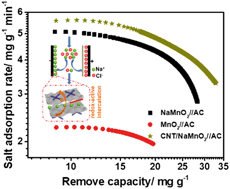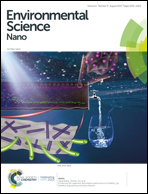Enhancing the capacitive deionization performance of NaMnO2 by interface engineering and redox-reaction†
Abstract
Capacitive deionization (CDI) is a promising electrochemical water desalination technology due to its advantages of low cost and high energy efficiency. However, the ion removal capacity (IRC) of CDI is insufficient for practical application because its capacity is limited by the electrochemical ad-/desorption capacity of porous carbon electrodes. Therefore, improving the IRC of a CDI system is one of the most urgent issues in CDI technology. Here, the self-assembly of two-dimensional (2D) MnO2 nanosheets with Na+ ions (NaMnO2) was carried out and the formation of sandwich structures with expanded interlayer distances was reported. Simultaneously, 3D CNT/NaMnO2 with high conductivity and porous structure was also designed and prepared. The two layered MnO2-based nanomaterials with expanded interlayer spacing and an open porous structure were evaluated as hybrid capacitive deionization (HCDI) redox-active intercalation electrodes. The two as-obtained materials with an open porous structure and expanded interlayer spacing can provide a short ion diffusion path and allow the Na+ ions to diffuse to the active sites more easily. Moreover, the high conductivity of CNT/NaMnO2 not only can facilitate ion diffusion, but also improve the utilization of NaMnO2 pseudocapacitive electrodes. As expected, both material-based cells demonstrated an excellent IRC of 28.3 and 40.0 mg g−1 for NaMnO2//AC and 32.7 and 42.6 mg g−1 for CNT/NaMnO2//AC in 500 and 20 000 mg L−1 NaCl solution, respectively. Additionally, the Na+ ion storage mechanism and the reason for capacity decay of these HCDI cells were explored. Consequently, NaMnO2 and CNT/NaMnO2 with an open porous structure and expanded interlayer spacing would be promising materials for application in HCDI systems.



 Please wait while we load your content...
Please wait while we load your content...